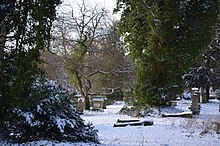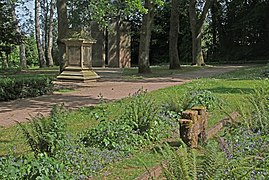Old cemetery (Pirmasens)
The old cemetery is an abandoned cemetery in Pirmasens that has been converted into a park. Numerous grave monuments from the 19th century, three war memorials and a partially preserved Jewish section are part of the city's list of monuments as the historic cemetery zone . The former consecration hall is now an event location under the name Carolinensaal .
location
The facilities of the former cemetery are located just outside the city center in the south of Horeb . The park is bordered by Friedhofstrasse and Buchsweilerstrasse in the south and Ottostrasse in the north. The west and east borders form Darmstädter Strasse and Strobelallee. To the south of the park in the direction of the Kirchberg lies the Wilhelminian-style Landauer-Tor district, while the city center begins on Bergstrasse in the west.
history
The cemetery was laid out around 1763 outside the city walls. The exact year is not known, the cemetery appears for the first time in a drawing from 1762, but at a different location. There it was intended to be placed directly in front of the Buchsweilertor on today's corner of Hauptstrasse and Bergstrasse, and it was finally placed at a higher point in the continuation of Alleestrasse. The cemetery already existed in 1765 at the latest. The oldest surviving relics in the cemetery are the grave monuments for two Prussian officers who died in the Battle of Pirmasens in 1793, Albrecht Otto Johann von Möllendorff and Hans Friedrich Georg von Borstell .
In 1858 and 1871 the area of the cemetery was expanded. From 1876 there was a Jewish section to replace the fully occupied cemetery on today's Zeppelinstrasse. Despite these expansions, the space for new graves was running out again, which is why the plan was to start a new cemetery from 1911. The plans could not be implemented until after the First World War , so that the new forest cemetery was inaugurated in 1924 . From around 1927, burials in new graves only took place there and the old cemetery was closed. However, burials in existing family graves were still possible until 1953.
Under the rule of the National Socialists , the Jewish part of the cemetery was devastated and leveled. In its place, a water pond was created for the neighboring fire station of the Pirmasens fire brigade . After the Second World War , only 17 Jewish graves could be re-erected.
Between 1973 and 1976 the former cemetery was converted into a city park, many graves were cleared, but some of the most valuable handicrafts and city history were preserved. After the war, the old sanctuary was used, among other things, as a depot for the city nursery and was temporarily intended for demolition. In 1986 it was placed under protection as a cultural monument, in 1993, after several years of renovation, it was inaugurated as the Carolinensaal , named after the great Landgrave Caroline of Hessen-Darmstadt . In 1998, nine modern sculptures were added to the park as part of an international sculpture symposium .
Investments
In the center of the site is the late classicist building of the former consecration hall, today's Carolinensaal, which was built around 1880. To the west of it is the oldest part of the cemetery, where most of the historical graves are located. The park's main path, which connects Buchsweiler and Ottostraße, leads past the Carolinensaal. Along the way and east of it are the sculptures of the sculpture park . The east of the area forms an extensive park with only very few preserved tombs. On the eastern edge there is a cemetery of honor and a memorial for those killed in the First World War, the base of a Germania monument by Gustav Eberlein for the Franco-German War of 1870/1871, as well as a modern memorial for the three wars of 1870/1871, 1914-1918 and 1939 - 1945, designed by Otto Rumpf .
Sculpture park
The sculpture park at the old cemetery is part of the Rhineland-Palatinate sculpture trail . The promotion of art projects in public space by the State of Rhineland-Palatinate led to the design of nine modern sandstone sculptures in 1998 with an international sculpture symposium. The works with associated artist are:
- Bertrand Ney : landscape table
- Villi Bossi: River of Tears
- Jian-Yong Zhang: silence / stone
- Detlef Kraft : Musicians
- Ingbert Brunk: I hear, I call
- Kubach & Kropp : One for the other
- Georg Ahrens : Combative angel
- Karl-Heinz Deutsch : Large head shape
- Ljubo de Karina: breakthrough
See also
literature
- International Sculptor Symposium Pirmasens , catalog, publisher: Stadt Pirmasens, 1998
Web links
Individual evidence
- ↑ Julius B. Lehnung: Beloved Pirmasens . 1st edition. Vol. 1 (740-1790). Komet-Verlag, Pirmasens 1978, ISBN 3-920558-00-6 , p. 121.
- ↑ Julius B. Lehnung: Beloved Pirmasens. 1st edition. Vol. 3 (1840-1875). Komet-Verlag, Pirmasens 1980, ISBN 3-920558-02-2 , p. 212.
- ↑ www.alemannia-judaica.de , accessed on February 12, 2018.
- ↑ Gerhard and Evelyn Stumpf: Beloved Pirmasens . 1st edition. Vol. 11 (1919-1929). Komet-Verlag, Pirmasens 1992, ISBN 3-920558-15-4 , p. 147.
- ^ General Directorate for Cultural Heritage Rhineland-Palatinate (ed.): Informational directory of cultural monuments - district-free city of Pirmasens. Mainz 2020, p. 4 (PDF; 6.3 MB).
- ↑ a b www.pirmasens.de , accessed on February 12, 2018.
- ↑ www.pirmasens.de , accessed on February 12, 2018.
- ^ Sculpture Paths in RLP: 1998 - Sculpture Park Alter Friedhof , accessed on February 12, 2018.
- ↑ Rhineland-Palatinate Bibliography: Impressions from the Pirmasens Sculptor Symposium .
Coordinates: 49 ° 11 ′ 45.1 ″ N , 7 ° 36 ′ 46.7 ″ E






